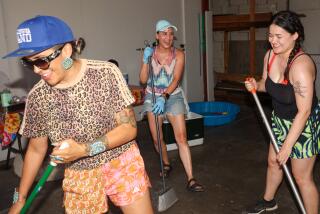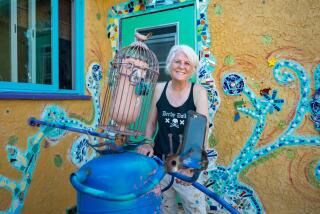Opening Creativity’s Doors : Artist Helps Orangewood Kids Have Fun While Building Self-Esteem
ORANGE — Mary-Linn Hughes was surprised when a child in her art class said the haunted house they were planning would have no PC.
As Hughes found out, the missing element was not a personal computer, nor even political correctness. Rather, she was referring to “physical contact”--a strict no-no between boys and girls at Orangewood Children’s Home, a refuge for victimized children where Hughes is artist in residence.
“Another (child) said they’d like a TR on Saturday; that is a temporary release. That’s one thing I had to learn here, was all the language the kids threw at me,” Hughes said.
Learning new lingo is just one of the adjustments Hughes has made since she became artist-in-residence at the children’s home. She’s working there with the aid of a California Arts Council grant and an additional grant from the children’s home auxiliary (La Casa) and the Orangewood Children’s Foundation.
Orangewood Children’s Home houses Orange County children who have been physically or sexually abused or abandoned by their families. It is a short-term shelter, with the length of stays ranging from a few days to several months.
For the second time, Hughes is the only Orange County artist to receive an Artists in Residence grant from the CAC. She was previously awarded a grant in 1989 to work with people with AIDS.
Hughes said she knew she wanted to apply for another grant but was searching for a new project and a new challenge.
“I had never worked with children before, and I felt there was a lot to learn there,” Hughes said. “Children are in touch with their creativity, which is something we tend to lose when we become adults.”
With the help of John Alberti, a counselor at Orangewood, Hughes prepared a proposal for the CAC grant. Still, she was surprised when she was got it.
“With all the budget problems the state was having, I wasn’t sure they were going to be able to award the grants,” she said.
As her inaugural project, Hughes invited the staff to join her pupils in making masks, a project that proved a hit with all involved. “By getting the staff involved, the kids decided it’s cool enough for them to do,” Hughes said.
The grant is designed to put the artist in a community to share skills, whether they be in dance, theater, or art, at schools, hospitals, senior centers, community centers or other facilities.
Hughes receives $900 a month until September from the state, and an additional $500 to be used for guest artists. La Casa also pays Hughes $400 monthly. The CAC grant is renewable up to three years.
“It’s my understanding that when Orangewood was built it was a cooperation of public and private funds,” Hughes said. “This grant is a good model of that.”
Certainly the grant is not going to make Hughes rich. She said her real rewards come from watching the children open up to their creative sides.
Said Rick Bazant, community program specialist at Orangewood: “The children need a way to deal with their situations in their own ways. Most of these kids don’t have the verbal skills to do that. The art gives them a way to express themselves and build their self-esteem by accomplishing something of their own,” he said.
To further increase children’s self-esteem, much of their artwork is displayed throughout Orangewood, he added.
Hughes said the children’s art often reflects the traumas they’ve been through.
Guns and knives show up with regularity, although Hughes believes that could be a product of all society, not just these children’s experiences.
When given art projects to be used as gifts, they most often want to make things for family members.
“I had them make cards for President Clinton to give him any advice or message they wanted. One kid wrote that he’d like to be with his mom and dad in Hawaii,” she said. “It’s things like that, that remind you these kids are in an unusual situation.”
Hughes does not gear her art lessons to any kind of healing treatment or therapy session. Instead, she tries to give the children basic art skills and projects that will encourage an appreciation for art.
Alberti also figures that this approach is the best way for the children to enjoy themselves.
“I think what I like best, is that this is not a therapy program,” he said. “It’s art for arts’ sake. You can therapy kids to death; what they also need is just to have fun.”
Hughes’ quiet manner and easygoing demeanor are also a hit with the kids. As one 8-year-old girl put it: “She’s better than the teacher at my original school. If you do something wrong, she just tells you; she doesn’t get mad.”
In fact, added Bazant: “How successful an artist (Hughes) is doesn’t hold much weight with them. What counts is that she is interested in them. They are impressed with what she does with them (by) giving them her time.”
Watching Hughes oversee a guest artist trying to explain the fundamentals of watercolor painting to a group girls between 8 and 13 years old, it’s easy to see how patient she is with the pupils.
When children asked questions that flustered the guest artist, such as why one paintbrush costs more than another, Hughes took the opportunity to explain how expensive art supplies are and why brushes should be used in a certain way to guarantee longevity.
Hughes spends Mondays, Thursdays and Saturdays at Orangewood. Her classroom, which doubles as the home’s library, is lined with handmade masks and paintings, all created children. There are several small round tables and chairs that students use to create their artworks.
“I love this room,” Hughes said. “It’s great to teach art in a room filled with books; it ties in all kinds of creativity. It really feeds the artists involved in interesting ways. I’m not just paid to work with them, but to grow with them and be inspired by them.”
More to Read
Sign up for Essential California
The most important California stories and recommendations in your inbox every morning.
You may occasionally receive promotional content from the Los Angeles Times.










